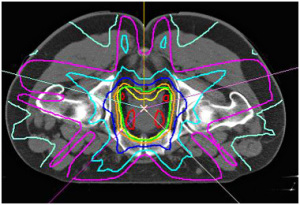Machine Learning Could Speed Up Radiation Therapy for Cancer Patients
by Barbara Kram, Editor | February 13, 2007

New algorithm contours
dosing for prostate treatment
Click to enlarge image
dosing for prostate treatment
Click to enlarge image
Troy, N.Y. - A new computer-based technique could eliminate hours of manual adjustment associated with a popular cancer treatment. In a paper published in the Feb. 7 issue of Physics in Medicine and Biology, researchers from Rensselaer Polytechnic Institute describe an approach that has the potential to automatically determine acceptable radiation plans in a matter of minutes, without compromising the quality of treatment.
The automatic radiation planning algorithm results in beamlet intensities that produce equal-dose contours. The prostate (center) receives a high dose, while nearby tissue receives a low dose.
"Intensity Modulated Radiation Therapy (IMRT) has exploded in popularity, but the technique can require hours of manual tuning to determine an effective radiation treatment for a given patient," said Richard Radke, assistant professor of electrical, computer, and systems engineering at Rensselaer. Radke is leading a team of engineers and medical physicists to develop a "machine learning" algorithm that could cut hours from the process.
A subfield of artificial intelligence, machine learning is based on the development of algorithms that allow computers to learn relationships in large datasets from examples. Radke and his coworkers have tested their algorithm on 10 prostate cancer patients. They found that for 70 percent of the cases, the algorithm automatically determined an appropriate radiation therapy plan in about 10 minutes.
"The main goal of radiation therapy is to irradiate a tumor with a very high dose, while avoiding all of the healthy organs," Radke said. He described early versions of radiation therapy as a "fire hose" approach, applying a uniform stream of particles to overwhelm cancer cells with radiation.
IMRT adds nuance and flexibility to radiation therapy, increasing the likelihood of treating a tumor without endangering surrounding healthy tissue. Each IMRT beam is composed of thousands of tiny "beamlets" that can be individually modulated to deliver the right level of radiation precisely where it is needed.
But the semi-automatic process of developing a treatment plan can be extremely time-consuming - up to about four hours for prostate cancer and up to an entire day for more complicated cancers in the head and neck, according to Radke.
A radiation planner must perform a CT scan, analyze the image to determine the exact locations of the tumor and healthy tissues, and define the radiation levels that each area should receive. Then the planner must give weight to various constraints set by a doctor, such as allowing no more than a certain level of radiation to hit a nearby organ, while assuring that the tumor receives enough to kill the cancerous cells.
The automatic radiation planning algorithm results in beamlet intensities that produce equal-dose contours. The prostate (center) receives a high dose, while nearby tissue receives a low dose.
"Intensity Modulated Radiation Therapy (IMRT) has exploded in popularity, but the technique can require hours of manual tuning to determine an effective radiation treatment for a given patient," said Richard Radke, assistant professor of electrical, computer, and systems engineering at Rensselaer. Radke is leading a team of engineers and medical physicists to develop a "machine learning" algorithm that could cut hours from the process.
A subfield of artificial intelligence, machine learning is based on the development of algorithms that allow computers to learn relationships in large datasets from examples. Radke and his coworkers have tested their algorithm on 10 prostate cancer patients. They found that for 70 percent of the cases, the algorithm automatically determined an appropriate radiation therapy plan in about 10 minutes.
"The main goal of radiation therapy is to irradiate a tumor with a very high dose, while avoiding all of the healthy organs," Radke said. He described early versions of radiation therapy as a "fire hose" approach, applying a uniform stream of particles to overwhelm cancer cells with radiation.
IMRT adds nuance and flexibility to radiation therapy, increasing the likelihood of treating a tumor without endangering surrounding healthy tissue. Each IMRT beam is composed of thousands of tiny "beamlets" that can be individually modulated to deliver the right level of radiation precisely where it is needed.
But the semi-automatic process of developing a treatment plan can be extremely time-consuming - up to about four hours for prostate cancer and up to an entire day for more complicated cancers in the head and neck, according to Radke.
A radiation planner must perform a CT scan, analyze the image to determine the exact locations of the tumor and healthy tissues, and define the radiation levels that each area should receive. Then the planner must give weight to various constraints set by a doctor, such as allowing no more than a certain level of radiation to hit a nearby organ, while assuring that the tumor receives enough to kill the cancerous cells.
1(current)









